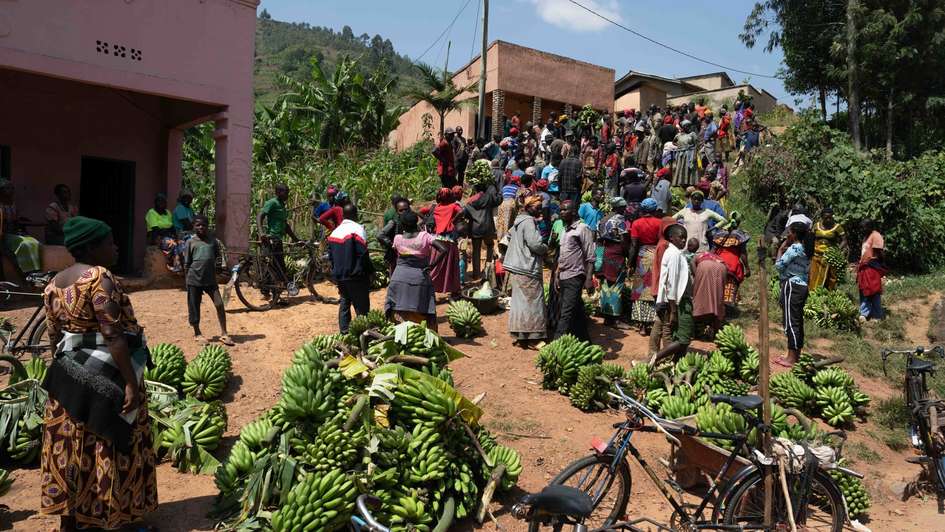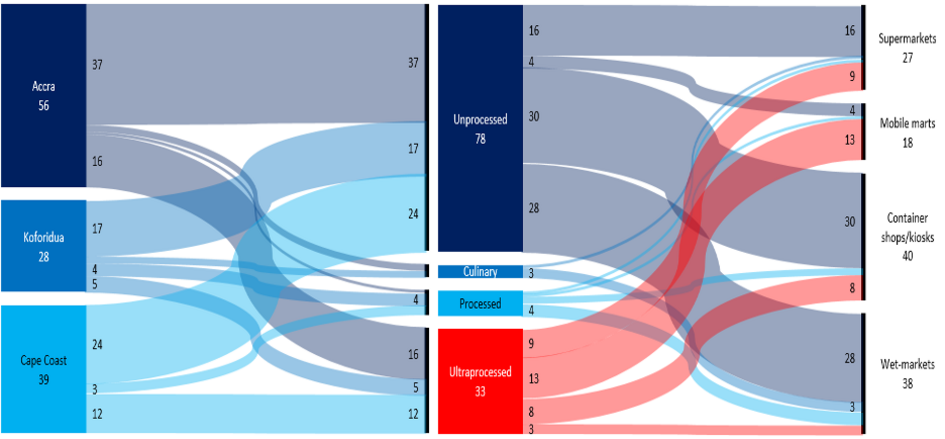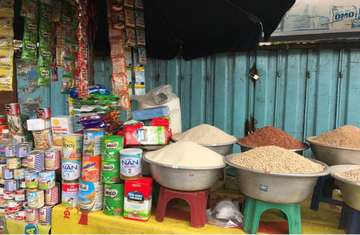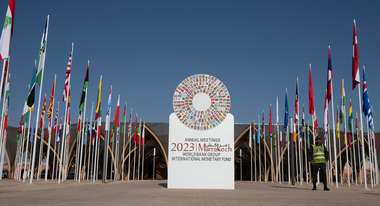Rapidly urbanizing food environments in Africa: Policies for achieving food and nutrition security
Increasing urbanization is transforming the eating habits of the African population: city dwellers are eating fewer fruits and vegetables. New strategies are needed to combat malnutrition and its consequences.

Food environments in Africa are changing rapidly due to urbanization spurred by economic growth, population increase, and rural-urban migration. This change poses a challenge to food and nutrition security in urban areas and African megacities such as Accra, Kinshasa, Lagos, and Nairobi, as consumers are increasingly demanding convenient processed food. With the wave of supermarket revolution, the urban food environments are responding by supplying affordable ultra-processed foods. The consequence is the triple burden of malnutrition with rising incidences of obesity, undernutrition and micronutrient deficiencies – leading to nutrition-related diseases.
A recent study examined the availability, accessibility, and affordability of the food environment in three urban Ghanaian cities, as well as the extent to which foods are processed. The findings point toward serious potential population health implications. The study presents an array of policy instruments for achieving food and nutrition security in urban areas.
In many developing countries, food systems and dietary patterns are changing rapidly. Urbanization, employment and income growth, modernization of the retail sector, and demands for convenience shopping are altering food environments, and, as a result, dietary patterns. Recent estimates show that 10–30% of processed foods are ultra-processed in urban food environments1. On the flipside, consumption of vegetables and fruits in urban areas are extremely low. A study examining eating practices in urban areas in Ghana, shows that just 14.5% consumed vegetables and 8.0% ate fruits in the last 24 hours2.
Increasingly, populations in developing countries are moving away from traditional diets rich in complex carbohydrates and fiber towards more westernized diets with higher proportions of sugars, fats, and animal-sourced foods3. For most consumers where high food prices and low incomes are the current reality, food environments constrain food choices to accessible and affordable processed foods.
These shifts affect public health. In the urban cities of many African countries, nutrition transitions have been associated with increased nutrition-related diseases such as obesity, diabetes, cardiovascular disease, and certain types of cancers that are co-existing with undernutrition issues, such as stunting and wasting, and micronutrient deficiencies4,5. In many African countries, obesity is increasing, ranging from 13–31% of the population. In Ghana, the prevalence of obesity and overweight increased by 25% in 2014/2015. This simultaneous occurrence of overnutrition, undernutrition, and micronutrient deficiencies is often called the “triple burden of malnutrition”, and it has serious public health implications in sub-Saharan Africa (SSA)6,7.
To gain insight into the urban food environment and assess how policies could be implemented to curb the triple burden of malnutrition, we recently conducted a study published in World Development Perspectives to evaluate the food environments in three cities in Ghana. A total of 123 food retail outlets were sampled in high- and low-income urban areas across Accra, Cape Coast, and Koforidua to take stock of food availability, accessibility, and affordability, as well as the degree to which foods are processed.
With an estimated 57% of the population residing in urban centers and adult obesity rates that have increased five-fold between 1980 and 2015, Ghana represents many of the demographic, epidemiologic, and economic trends found in other SSA countries, making it a strategic case study for the region at large8, 9, 10.
Are nutritious foods widely available in urban Ghana?
To assess the extent to which healthy foods are available in Ghanaian urban markets, four main food categories are examined: (1) unprocessed or minimally processed foods (seeds, fruits, roots, leaves, meat, eggs, milk, fungi), (2) processed culinary ingredients (oils, butter, sugar), (3) processed foods (bread, cheeses, canned fish), and (4) ultra-processed (chips, savory packaged snacks, soft drinks).
The evidence shows that almost all (97%) of the retail outlets sampled across the three cities sell unprocessed foods, followed by processed culinary ingredients (81%), processed foods (80%), and ultra-processed foods (65%). Additionally, all four food categories are either highly available or available in the urban markets; ultra-processed and unprocessed foods are highly available and processed culinary ingredients and processed foods are less highly available. The insights also show that processed foods account for the larger share of all foods in Ghana’s urban food environment, and ultra-processed foods account for more than 30% of all processed foods.
In terms of food sources, unprocessed foods are mostly sourced from or are dominant in container shops/kiosks, wet markets, and supermarkets. As expected, ultra-processed foods are mostly found in mobile marts, supermarkets, and container shops/kiosks, with a few wet markets also stocking ultra-processed foods. For instance, out of the 33 retail outlets whose stock predominantly contains ultra-processed foods, nine are supermarkets, 13 are mobile marts, eight are container shops, and three are wet markets. Processed culinary ingredients and processed foods are mostly sourced from wet markets (See Figure 1).
While the high availability of unprocessed foods in Ghana’s urban food environment is welcome, the widespread availability of ultra-processed and processed foods may encourage the overconsumption of energy-dense foods and that can cause serious public health problems.

What about the accessibility and affordability of healthy choices?
In addition to being highly available, nutritious foods need to be easy to find and appropriately priced for consumers to be able to purchase the items that make up a healthy diet. To test these two dimensions of food security, the accessibility and affordability of the four food categories were also assessed.
The insights suggest that each food category, ranging from unprocessed to ultra-processed, is either highly accessible or accessible in the markets we studied. Like the trends in food availability, ultra-processed and unprocessed foods are highly accessible with processed culinary ingredients and processed foods being slightly less accessible.
Since diets with a strong emphasis on unprocessed foods, such as fresh fruits and vegetables, plant-based fats and proteins, legumes, whole grains, and nuts are often promoted as part of healthy diets, the high accessibility of unprocessed foods is good from a dietary pattern perspective. However, the high accessibility of ultra-processed foods gives cause for concern in terms of potential health risks such as obesity and other nutrition-related diseases that stem from the increased consumption of ultra-processed foods.
To corroborate our findings, we analyzed the share of each of the food categories in the retail outlets’ stock, finding that the combined share of processed, processed culinary ingredients, and ultra-processed foods make up the majority (55%) of Ghana’s food environment, while the share of ultra-processed food is 30%.
In sum, the results show that ultra-processed foods are just as available, accessible, and affordable as other food categories. However, in some instances, ultra-processed foods are even more available, accessible, or affordable than less processed foods, and processed foods of all kinds make up the larger share of all food categories in Ghana.
How can we nudge the urban food environment to offer healthy and nutritious diets?

Given the high share of ultra-processed foods in urban Ghana, diseases related to over-nutrition, such as obesity and diabetes, are on the rise, and diseases related to under-nutrition, such as wasting and stunting, persist, what can be done to ease these population health burdens and ensure healthy food environments?
One possible solution is the imposition of taxes on unhealthy foods (“sin tax”) and subsidies on healthy foods. Because the demand for ultra-processed food often responds by a larger magnitude to changes in prices (price elastic) , taxes generally have the desired effects on prices and consumption of unhealthy foods. Taxes on ultra-processed food increases the price passed on to consumers, and thus reduce the quantity demanded and consumed. With taxes, the triple burden of malnutrion problem associated with consumption of ultra-processed foods, and corresponding economic, social and public health costs (negative externality) are also reduced11, 12.. Likewise, subsidies on healthy foods, such as fresh fruits and vegetables, legumes, whole grains, and nuts, have been shown to increase their consumption, and therefore, a combination of taxes would amplify the benefits of these two policy instruments13.
Food and beverage companies can also be encouraged to advertise responsibly by reducing their targeting to children of less healthy foods and improving label legibility so that consumers can more easily use the product nutrition information.
Finally, governments can act by enforcing accurate food labels or even front-of package warnings to improve consumer comprehension of nutritional information. Sub-governments can also use zoning laws to limit the density of retail outlets selling unhealthy foods and encourage outlets selling healthy foods, particularly in public spaces, which would limit the demand and eventually supply of unhealthy food products and increase the availability and accessibility of more nutritious options14. Investments for research and development for fruits and vegetables, and food supply infrastructure, such as electricity, water, and cold chains, also work to promote the inter-seasonal availability of perishable foods and high-quality food items.
This research was undertaken with funding provided by the CGIAR National Policies and Strategies for food, land, and water systems transformation (NPS) initiative.
Further reading
1Reardon, T., Echeverria, R., Berdegué, J., Minten, B., Liverpool-Tasie, S., Tschirley, D., & Zilberman, D. (2019). Rapid transformation of food systems in developing regions: highlighting the role of agricultural research & innovations. Agricultural systems, 172, 47–59.
2Holdsworth, M., Pradeilles, R., Tandoh, A., et al. 2020. Unhealthy eating practices of city
Dwelling Africans in deprived neighbourhoods: Evidence for policy action from Ghana and
Kenya. Global Food Security, 26, 100452.
3 A. Drewnowski, B.M. Popkin. The nutrition transition: New trends in the global diet
Nutrition Reviews, 55 (2) (1997), pp. 31-43
4 R. Wanyama, T. Gödecke, C.G. Chege, M. Qaim How important are supermarkets for the diets of the urban poor in Africa? Food Security, 11 (6) (2019), pp. 1339-1353
5 T. Reardon, D. Tschirley, L.S.O. Liverpool-Tasie, T. Awokuse, J. Fanzo, B. Minten, ..., B.M. Popkin The processed food revolution in African food systems and the double burden of malnutrition Global Food Security, 28 (2021), p. 100466
6 P. Pinstrup-Andersen. Agricultural research and policy for better health and nutrition in developing countries: A food systems approach Agricultural Economics, 37 (2007), pp. 187-198
7J.V. Meenakshi Trends and patterns in the triple burden of malnutrition in India Agricultural Economics, 47 (S1) (2016), pp. 115-134
8 UNDESA (United Nations, Department of Economic and Social Affairs, Population Division). (2018). World Urbanization Prospects: The 2018 Revision (ST/ESA/SER.A/420). New York: United Nations
9 UNDESA (United Nations, Department of Economic and Social Affairs, Population Division) World Population Prospects: The 2019 Revision United Nations, New York (2019)
10 A. Laar, A. Barnes, R. Aryeetey, A. Tandoh, K. Bash, K. Mensah, ..., M. Holdsworth
Implementation of healthy food environment policies to prevent nutrition-related non-communicable diseases in Ghana: National experts’ assessment of government action Food Policy, 93 (2020), p. 101907
11 N. Stacey, A. Tugendhaft, K. Hofman Sugary beverage taxation in South Africa: Household expenditure, demand system elasticities, and policy implications Preventive Medicine, 105 (2017), pp. S26-S31
12 L.L. Hagenaars, P.P.T. Jeurissen, N.S. Klazinga The taxation of unhealthy energy-dense foods (EDFs) and sugar-sweetened beverages (SSBs): An overview of patterns observed in the policy content and policy context of 13 case studies Health Policy, 121 (8) (2017), pp. 887-894
13 R. An, D. Patel, D. Segal, R. Sturm Eating better for less: A national discount program for healthy food purchases in South Africa American Journal of Health Behavior, 37 (1) (2013), pp. 56-61
14 Sturm, R., & Cohen, D. A. (2009). Zoning for health? The year-old ban on new fast-food restaurants in South LA: The ordinance isn’t a promising approach to attacking obesity. Health Affairs, 28(Suppl1), w1088-w1097




